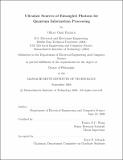| dc.contributor.advisor | Franco N.C. Wong. | en_US |
| dc.contributor.author | Kuzucu, Oktay Onur, 1980- | en_US |
| dc.contributor.other | Massachusetts Institute of Technology. Dept. of Electrical Engineering and Computer Science. | en_US |
| dc.date.accessioned | 2009-06-25T20:34:43Z | |
| dc.date.available | 2009-06-25T20:34:43Z | |
| dc.date.copyright | 2008 | en_US |
| dc.date.issued | 2008 | en_US |
| dc.identifier.uri | http://hdl.handle.net/1721.1/45615 | |
| dc.description | Thesis (Ph. D.)--Massachusetts Institute of Technology, Dept. of Electrical Engineering and Computer Science, 2008. | en_US |
| dc.description | This electronic version was submitted by the student author. The certified thesis is available in the Institute Archives and Special Collections. | en_US |
| dc.description | Includes bibliographical references (p. 191-209). | en_US |
| dc.description.abstract | Recent advances in quantum information processing (QIP) have enabled practical applications of quantum mechanics in various fields such as cryptography, computation, and metrology. Most of these applications use photons as carriers of quantum information. Therefore, engineering the quantum state of photons is essential for the realization of novel QIP schemes. A practical and flexible technique to generate high-purity entangled photon pairs is spontaneous parametric downconversion (SPDC) which finds its use in many QIP applications such as quantum key distribution (QKD) and linear optics quantum computation. SPDC is often used with ultrafast lasers to generate photon pairs with precise timing and engineered spectral properties. In this thesis, we focused on two photonic QIP applications using ultrafastpumped SPDC. We first pursued the design and implementation of a pulsed narrowband polarization-entangled photon pairs at 780nm for free-space entanglement-based QKD. We built and characterized a compact narrowband ultraviolet pump source and a polarization-entangled photon source based on SPDC in a polarization Sagnac interferometer. We then studied the generation of coincident-frequency entangled photons for Heisenberg-limited quantum metrology. Using extended phase-matching conditions in a periodically-poled KTP crystal, generation of coincident-frequency entanglement was verified and frequency indistinguishability was achieved for broadband signal and idler photons at ~1.58 [mu]m. We also developed a novel time domain characterization technique based on time-resolved single-photon upconversion. Using this technique, we measured the joint temporal density of a two-photon state for the first time and observed temporal anti-correlation for the coincident-frequency entangled state as predicted by Fourier duality. This new technique complements existing frequency domain methods for a more complete characterization of two-photon states. | en_US |
| dc.description.statementofresponsibility | by Oktay Onur Kuzucu. | en_US |
| dc.format.extent | 209 p. | en_US |
| dc.language.iso | eng | en_US |
| dc.publisher | Massachusetts Institute of Technology | en_US |
| dc.rights | M.I.T. theses are protected by
copyright. They may be viewed from this source for any purpose, but
reproduction or distribution in any format is prohibited without written
permission. See provided URL for inquiries about permission. | en_US |
| dc.rights.uri | http://dspace.mit.edu/handle/1721.1/7582 | en_US |
| dc.subject | Electrical Engineering and Computer Science. | en_US |
| dc.title | Ultrafast sources of entangled photons for quantum information processing | en_US |
| dc.type | Thesis | en_US |
| dc.description.degree | Ph.D. | en_US |
| dc.contributor.department | Massachusetts Institute of Technology. Department of Electrical Engineering and Computer Science | |
| dc.identifier.oclc | 320080860 | en_US |
